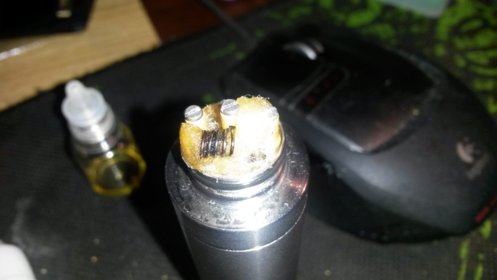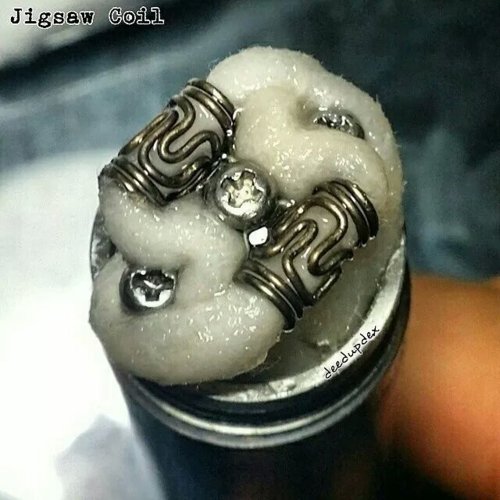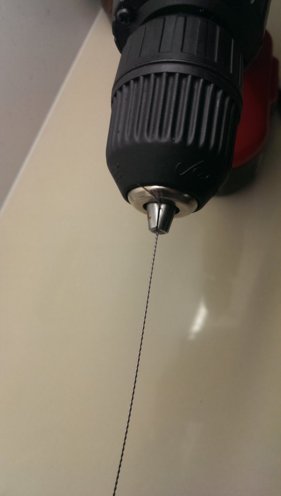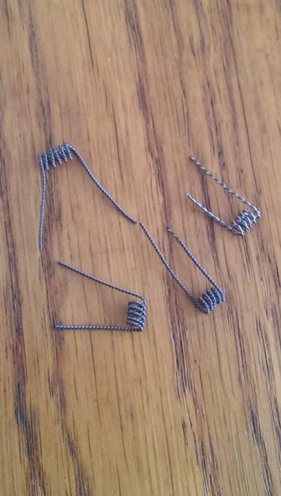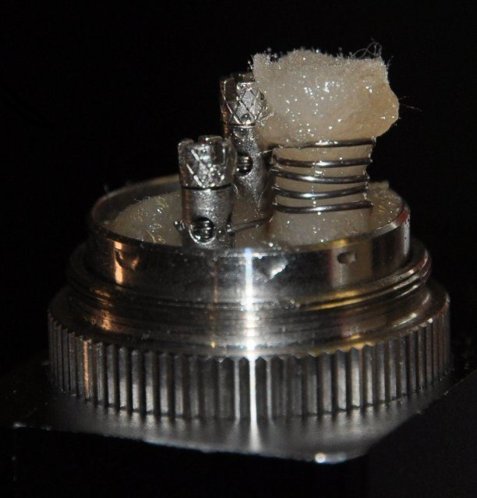Came accross an interesting discussion on ECF on this question. The part in black below was MacTechVpr's answer to this question by one Rudy. The part in blue was another member's response. And the last part (below the line) was MacTechVpr's reply to this response. You be the judge! Link to that page at the very bottom.
Thanks your question rudy. Hey look the basic premise of my efforts here to teach tension Tension, yes! Tension winding is the key to achieving consistant wick compression (deflection) on every part of every wind in the coil. Thanks Mac for that innovation!is to get new vapors thinking in terms of basic electronics. What works most efficiently. Shorts less. Yes, shorts less. What I call hot spots.Delivers better vapor production. Simply attainable techniques. I never dreamed that tension coils could work that well myself. I'd been actually devoting my efforts to tensioned screw wraps and was extremely skeptical of the contact coil…for about two weeks! If I hadn't perfected the rest of the electrical principles to make it work in a tight tank rudy, I would've failed. But having accomplished that I've been trying to pay it back and get as many newcomers through as quickly as possible.
Short answer: A non-contact coil will produce less with less winds for a given length lacking the direct heat transfer potential and having a greater lead inefficiency (more wire heating air) as a percetange of the overall element.That's the math. I can't argue with it. Or reports otherwise. I would only ask those experiencing otherwise to help the rest of us appreciate how/why they got that. More efficient energy delivery to the wick surface should produce more vapor and flavor.Given your res on both coils is equal there would be no difference in lead efficiency. The non-contact coil will just be longer with less winds for a given res. The longer coil can actually be beneficial on a dripper where the terminals are further apart and often exceed the length of a contact coil.
Maybe not the best explanation but the wick delivers the juice to the coil. The percentage reaching the coil directly as by dripping or squonking is only a small part of that. There's actually a flow of fluid which far exceeds the incidental contact to the outer turns. Vaporization happens from the inside, not the outside. And the most active part of the coil is that which is touching the wet wick itself. That is where vaporization (the exchange of energy) is largely taking place. And this is why the amount of contact surface, it's uniformity of contact and consistent temperature are important. Exactly. With contact coils the wick can only contact the inside of the coil. With non-contact coils the wick can pooch out between the winds thereby offering more wick to wire surface area contact. The increased amount of juice in contact with the coil adds to the heatsink effect robbing the coil of heat.One of the reasons why non-contact coils require slightly more power for proper vaporization.This does not imo indicate a loss in efficiency but rather indicates simply that more juice is in contact with the coil.
Now, a lot of folks report that separated coil turns perform better. They can't electrically, not hand wound, as far less consistent and often shorting through lack of contact or undue proximity to others. They have to somewhat conform to a proper electrical wind in terms of symmetry or they're nowhere near as efficient and physically cannot deliver the efficiency to say produce an increase in vapor that would result in better flavor. Here here Mac, hand winds(winding on the wick) is not going to gitter dun. Tension winding on a screw mandrel (tensioned non-contact coil) offers all the benefits of tmc's save one....heatup time. A tncc will never heat as fast as a tmc partially due to increased juice-coil contact area and partially due to the lack of heat sharing between winds.But…a big but…some very dense juices can get easily clogged in a microcoil. That is true. That does not mean a microcoil or t.m.c. cannot deal with it. The laws of physics still apply regardless. Either it's efficient, or not. So it's a matter of finding the solution or compromise for that juice. In some cases rudy I don't think it's possible. Like extremely dense NET's. Not only will some not work in an m.c. or t.m.c, they'll hardly work in anything we might consider a vaporizer.
This is where tncc's shine.Dirty juices. The spaces between the winds allow the vapor to readily escape the coil instead of being shoved out the ends of a tmc. It just doesn't seem practical to send hot vapor back through the very wick that's responsible for delivering juice there to begin with if you're seeking maximum flavor or wick longevity. The wicking is a filter after all. Juices with larger pigments will get trapped in the wick travelling in both directions with tmc's; on the way in (liquid form) and on the way out (vapor form). Not so with tncc's. Only on the way in for the most part. That means more flavor molecules will reach the palate and the wicking lasts longer as stoney pigments are less likely to accumulate in the wick. These solidified pigments can and do seriously effect efficiency as well. After a while you are trying to heat a brick. Taking longer and longer draws to get the temp up.Think about what effect that has on battery life.
Often the answers are quite simple. People will actually buy a well made coil now and then, or build one, and find it doesn't produce. Most of us don't realize what's happened is that the coil needs two things we're not used to…more air and power! You just stepped hard on the gas pedal. There's a night and day difference between a standard wind and a proper electrical coil. If it's not observed, there's an element missing from the formula. This triangle is very similar in its dependencies to the combustion triangle (heat, fuel, air). Not enough air or power and you will flood the wick experiencing inadequate vaporization and ultimately junking your coil. That happens I'm afraid more often than not. I did it myself in early testing mistakenly concluding contact coils didn't work.
In your specific example, reducing wind count (same gauge) will cut your resistance not necessarily. Depends on how many winds were removed. With a tncc there is more wire needed for each turn to accommodate the spaces. and with voltage a constant you'd see more vapor (and perhaps flavor) simply from the resulting increase in power. And that by itself may have exceeded the net loss in efficiency. But that would not be necessarily more effective. The objective changed. It's about temperature. That's what we want to reproduce, consistently.An excellent point Mac. It is all about consistance temperature.
We'll it's pretty evident these days from the cloud blower results with microcoils we see everywhere that there's a whole lot of energy transfer going on. Again my concern is leveraging that technology to achieve a balance of flavor and vapor. That's the [lack of] compromise of efficiency I think most of us want.
In general a t.m.c. will let you put more turns in the same space, produce more heat transfer with the same wattage (or amps) and so more vapor…by virtue of the additional contact area (deflection of the wick) and uniformity of temperature delivery to the wick surface. You end up with a lesser percentile for the lead length (which btw is the measure of coil efficiency, electrically).see above The effect generally is that of a cooler vape at a given wattage. That is the dead giveaway you're getting efficiency. If the net effect of your non-contact wind is to produce more heat in your vape, you may get more cloud but have you actually vaporized more? If you haven't, where is the flavor coming from? And admittedly, I love clouds but not at the expense of flavor.
Coil separation my produce better flavor results for some with some juices. I've experienced it myself because I continue to test a variety of winding and wicking methods after analyzing many dozens of wick/wind approaches. My goal rudy is to get folks building a fundamentally correct baseline electrically. Then the sky's the limit. Then it's possible to analyze why a given juice might favor micro spaces between turns as you suggest or not (they're there in all coils, venting vapor).
But we got's to get 'em there first rud. That's where my head is at. I think the t.m.c.'s a good place to start because it's easy and easy to understand. But I build 'em all ways trying to find answers to your very question.Started my friends and family there too. Tmc's and protanks. Now that they have vaped tncc's for a few weeks now I am having a hard time getting any of them to revert back to tmc's to verify against the test metrics. Go figure.
I'm sure I haven't answered all your questions rudy. But I'd be happy to try based on what I've found so far. Few have run as much ceramic wick as I have in my studies. And it's my pleasure to share what I know.
Tap me on the shoulder anytime.
Take care and good luck.
_____________________________________________________________________________
Not gonna mince words with you gentlemen, LOL. The word deflection implies pooching. It's whatever part of the wick comes in contact with the coil (not at some point removed, we can only speculate at that calculation and its method). The deflection is what it is. It's based on the turns of wire and diameter. No magic here to spacing. The efficiency IS that contact surface. More lead length and wire length not in contact with coils is ineffeciency. Not my opinion but fact in electronics. Energy expended in the work is what we're calculating. Wire heating air is not producing work. In this case vaporization.
Wire length spent separating coils is not as efficient as the equivalent and additional wire length that could be deployed in a contact coil. So, the potential contact surface for a given length of element is increased. The lead length of a clearo is a constant. Increase the overall wind length by putting more turns into an element of a given lead length and you increase its work potential.
That ends the missive on efficiency.
Now, fellas who said vapor doesn't escape between the turns of an m.c. or t.m.c. (and it's under higher pressure so higher velocity). Can I see the proofs that it's a non-porous cylinder. My visual examinations would differ with the supposition.
I'm not gonna say you guys aren't gettin' the results you say. But the math don't suggest it. And I am truly very interested to understand the mechanics. You see if we understand what is happening it can be reproduced. I can't reproduce the effect you guys report. So you'll have to pardon my skepticism.
I will grant you the tight spacings (micro fissures and irregularities in a very tight t.m.c.) can close up very fast. Hours, as the coil surface accumulates caramelized deposits. That would seem to confirm your hypotheses if it could be demonstrated under magnification. However, vaporization is a violent process and even with t.m.c.'s turns have a tendency to have their adhesion disrupted and separation to ensue. So guys, I don't see the scientific explanation. That's my problem with your theory cig. The basis for the inefficiency cited is flawed by omission.
What I do see is that Nextel's hollow core delivers juice alongside the internal weave's inter-fiber channels. Heat pushes juice progressively along to channels more adjacent to the surface. Near the wick's surface channel flow is to the surface of the wick (and coils) and towards each end of the wick. This effect of vaporization emitting from the fiber channels is more readily apparent in a vertical coil situation. Nextel itself can be incredibly conductive of heat being capable of internalizing heat of >2200 deg. F. (that's not happening here BTW, more likely in the 200-300 deg. F range and probably towards the low side (but haven't done the IR studies of a Nextel surface).
Just sayin' fellas. I love those NET's about as much as any tobacco lover could. If it's possible to do, let's see how to get there. So far the maintenance plan I suggested some time ago cig, preventing agglomeration of pigments at the coil surface by frequent washing (using Nextel), is working for me with very dense juices to as much as quadruple the time I experience with alternatives. And why I'm a big fan.
Nevertheless, being the ever constant skeptic even of my own conclusions I'm undertaking another examination of spaced and multi-wire windings (for tobacco).
Best of luck to us fellas!
http://www.e-cigarette-forum.com/fo...yxwick-non-cotton-people-82.html#post13853744
Thanks your question rudy. Hey look the basic premise of my efforts here to teach tension Tension, yes! Tension winding is the key to achieving consistant wick compression (deflection) on every part of every wind in the coil. Thanks Mac for that innovation!is to get new vapors thinking in terms of basic electronics. What works most efficiently. Shorts less. Yes, shorts less. What I call hot spots.Delivers better vapor production. Simply attainable techniques. I never dreamed that tension coils could work that well myself. I'd been actually devoting my efforts to tensioned screw wraps and was extremely skeptical of the contact coil…for about two weeks! If I hadn't perfected the rest of the electrical principles to make it work in a tight tank rudy, I would've failed. But having accomplished that I've been trying to pay it back and get as many newcomers through as quickly as possible.
Short answer: A non-contact coil will produce less with less winds for a given length lacking the direct heat transfer potential and having a greater lead inefficiency (more wire heating air) as a percetange of the overall element.That's the math. I can't argue with it. Or reports otherwise. I would only ask those experiencing otherwise to help the rest of us appreciate how/why they got that. More efficient energy delivery to the wick surface should produce more vapor and flavor.Given your res on both coils is equal there would be no difference in lead efficiency. The non-contact coil will just be longer with less winds for a given res. The longer coil can actually be beneficial on a dripper where the terminals are further apart and often exceed the length of a contact coil.
Maybe not the best explanation but the wick delivers the juice to the coil. The percentage reaching the coil directly as by dripping or squonking is only a small part of that. There's actually a flow of fluid which far exceeds the incidental contact to the outer turns. Vaporization happens from the inside, not the outside. And the most active part of the coil is that which is touching the wet wick itself. That is where vaporization (the exchange of energy) is largely taking place. And this is why the amount of contact surface, it's uniformity of contact and consistent temperature are important. Exactly. With contact coils the wick can only contact the inside of the coil. With non-contact coils the wick can pooch out between the winds thereby offering more wick to wire surface area contact. The increased amount of juice in contact with the coil adds to the heatsink effect robbing the coil of heat.One of the reasons why non-contact coils require slightly more power for proper vaporization.This does not imo indicate a loss in efficiency but rather indicates simply that more juice is in contact with the coil.
Now, a lot of folks report that separated coil turns perform better. They can't electrically, not hand wound, as far less consistent and often shorting through lack of contact or undue proximity to others. They have to somewhat conform to a proper electrical wind in terms of symmetry or they're nowhere near as efficient and physically cannot deliver the efficiency to say produce an increase in vapor that would result in better flavor. Here here Mac, hand winds(winding on the wick) is not going to gitter dun. Tension winding on a screw mandrel (tensioned non-contact coil) offers all the benefits of tmc's save one....heatup time. A tncc will never heat as fast as a tmc partially due to increased juice-coil contact area and partially due to the lack of heat sharing between winds.But…a big but…some very dense juices can get easily clogged in a microcoil. That is true. That does not mean a microcoil or t.m.c. cannot deal with it. The laws of physics still apply regardless. Either it's efficient, or not. So it's a matter of finding the solution or compromise for that juice. In some cases rudy I don't think it's possible. Like extremely dense NET's. Not only will some not work in an m.c. or t.m.c, they'll hardly work in anything we might consider a vaporizer.
This is where tncc's shine.Dirty juices. The spaces between the winds allow the vapor to readily escape the coil instead of being shoved out the ends of a tmc. It just doesn't seem practical to send hot vapor back through the very wick that's responsible for delivering juice there to begin with if you're seeking maximum flavor or wick longevity. The wicking is a filter after all. Juices with larger pigments will get trapped in the wick travelling in both directions with tmc's; on the way in (liquid form) and on the way out (vapor form). Not so with tncc's. Only on the way in for the most part. That means more flavor molecules will reach the palate and the wicking lasts longer as stoney pigments are less likely to accumulate in the wick. These solidified pigments can and do seriously effect efficiency as well. After a while you are trying to heat a brick. Taking longer and longer draws to get the temp up.Think about what effect that has on battery life.
Often the answers are quite simple. People will actually buy a well made coil now and then, or build one, and find it doesn't produce. Most of us don't realize what's happened is that the coil needs two things we're not used to…more air and power! You just stepped hard on the gas pedal. There's a night and day difference between a standard wind and a proper electrical coil. If it's not observed, there's an element missing from the formula. This triangle is very similar in its dependencies to the combustion triangle (heat, fuel, air). Not enough air or power and you will flood the wick experiencing inadequate vaporization and ultimately junking your coil. That happens I'm afraid more often than not. I did it myself in early testing mistakenly concluding contact coils didn't work.
In your specific example, reducing wind count (same gauge) will cut your resistance not necessarily. Depends on how many winds were removed. With a tncc there is more wire needed for each turn to accommodate the spaces. and with voltage a constant you'd see more vapor (and perhaps flavor) simply from the resulting increase in power. And that by itself may have exceeded the net loss in efficiency. But that would not be necessarily more effective. The objective changed. It's about temperature. That's what we want to reproduce, consistently.An excellent point Mac. It is all about consistance temperature.
We'll it's pretty evident these days from the cloud blower results with microcoils we see everywhere that there's a whole lot of energy transfer going on. Again my concern is leveraging that technology to achieve a balance of flavor and vapor. That's the [lack of] compromise of efficiency I think most of us want.
In general a t.m.c. will let you put more turns in the same space, produce more heat transfer with the same wattage (or amps) and so more vapor…by virtue of the additional contact area (deflection of the wick) and uniformity of temperature delivery to the wick surface. You end up with a lesser percentile for the lead length (which btw is the measure of coil efficiency, electrically).see above The effect generally is that of a cooler vape at a given wattage. That is the dead giveaway you're getting efficiency. If the net effect of your non-contact wind is to produce more heat in your vape, you may get more cloud but have you actually vaporized more? If you haven't, where is the flavor coming from? And admittedly, I love clouds but not at the expense of flavor.
Coil separation my produce better flavor results for some with some juices. I've experienced it myself because I continue to test a variety of winding and wicking methods after analyzing many dozens of wick/wind approaches. My goal rudy is to get folks building a fundamentally correct baseline electrically. Then the sky's the limit. Then it's possible to analyze why a given juice might favor micro spaces between turns as you suggest or not (they're there in all coils, venting vapor).
But we got's to get 'em there first rud. That's where my head is at. I think the t.m.c.'s a good place to start because it's easy and easy to understand. But I build 'em all ways trying to find answers to your very question.Started my friends and family there too. Tmc's and protanks. Now that they have vaped tncc's for a few weeks now I am having a hard time getting any of them to revert back to tmc's to verify against the test metrics. Go figure.
I'm sure I haven't answered all your questions rudy. But I'd be happy to try based on what I've found so far. Few have run as much ceramic wick as I have in my studies. And it's my pleasure to share what I know.
Tap me on the shoulder anytime.
Take care and good luck.
_____________________________________________________________________________
Not gonna mince words with you gentlemen, LOL. The word deflection implies pooching. It's whatever part of the wick comes in contact with the coil (not at some point removed, we can only speculate at that calculation and its method). The deflection is what it is. It's based on the turns of wire and diameter. No magic here to spacing. The efficiency IS that contact surface. More lead length and wire length not in contact with coils is ineffeciency. Not my opinion but fact in electronics. Energy expended in the work is what we're calculating. Wire heating air is not producing work. In this case vaporization.
Wire length spent separating coils is not as efficient as the equivalent and additional wire length that could be deployed in a contact coil. So, the potential contact surface for a given length of element is increased. The lead length of a clearo is a constant. Increase the overall wind length by putting more turns into an element of a given lead length and you increase its work potential.
That ends the missive on efficiency.
Now, fellas who said vapor doesn't escape between the turns of an m.c. or t.m.c. (and it's under higher pressure so higher velocity). Can I see the proofs that it's a non-porous cylinder. My visual examinations would differ with the supposition.
I'm not gonna say you guys aren't gettin' the results you say. But the math don't suggest it. And I am truly very interested to understand the mechanics. You see if we understand what is happening it can be reproduced. I can't reproduce the effect you guys report. So you'll have to pardon my skepticism.
I will grant you the tight spacings (micro fissures and irregularities in a very tight t.m.c.) can close up very fast. Hours, as the coil surface accumulates caramelized deposits. That would seem to confirm your hypotheses if it could be demonstrated under magnification. However, vaporization is a violent process and even with t.m.c.'s turns have a tendency to have their adhesion disrupted and separation to ensue. So guys, I don't see the scientific explanation. That's my problem with your theory cig. The basis for the inefficiency cited is flawed by omission.
What I do see is that Nextel's hollow core delivers juice alongside the internal weave's inter-fiber channels. Heat pushes juice progressively along to channels more adjacent to the surface. Near the wick's surface channel flow is to the surface of the wick (and coils) and towards each end of the wick. This effect of vaporization emitting from the fiber channels is more readily apparent in a vertical coil situation. Nextel itself can be incredibly conductive of heat being capable of internalizing heat of >2200 deg. F. (that's not happening here BTW, more likely in the 200-300 deg. F range and probably towards the low side (but haven't done the IR studies of a Nextel surface).
Just sayin' fellas. I love those NET's about as much as any tobacco lover could. If it's possible to do, let's see how to get there. So far the maintenance plan I suggested some time ago cig, preventing agglomeration of pigments at the coil surface by frequent washing (using Nextel), is working for me with very dense juices to as much as quadruple the time I experience with alternatives. And why I'm a big fan.
Nevertheless, being the ever constant skeptic even of my own conclusions I'm undertaking another examination of spaced and multi-wire windings (for tobacco).
Best of luck to us fellas!
http://www.e-cigarette-forum.com/fo...yxwick-non-cotton-people-82.html#post13853744



